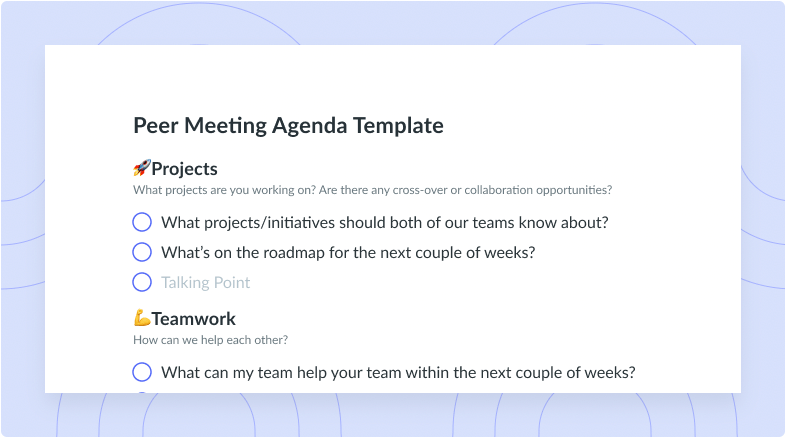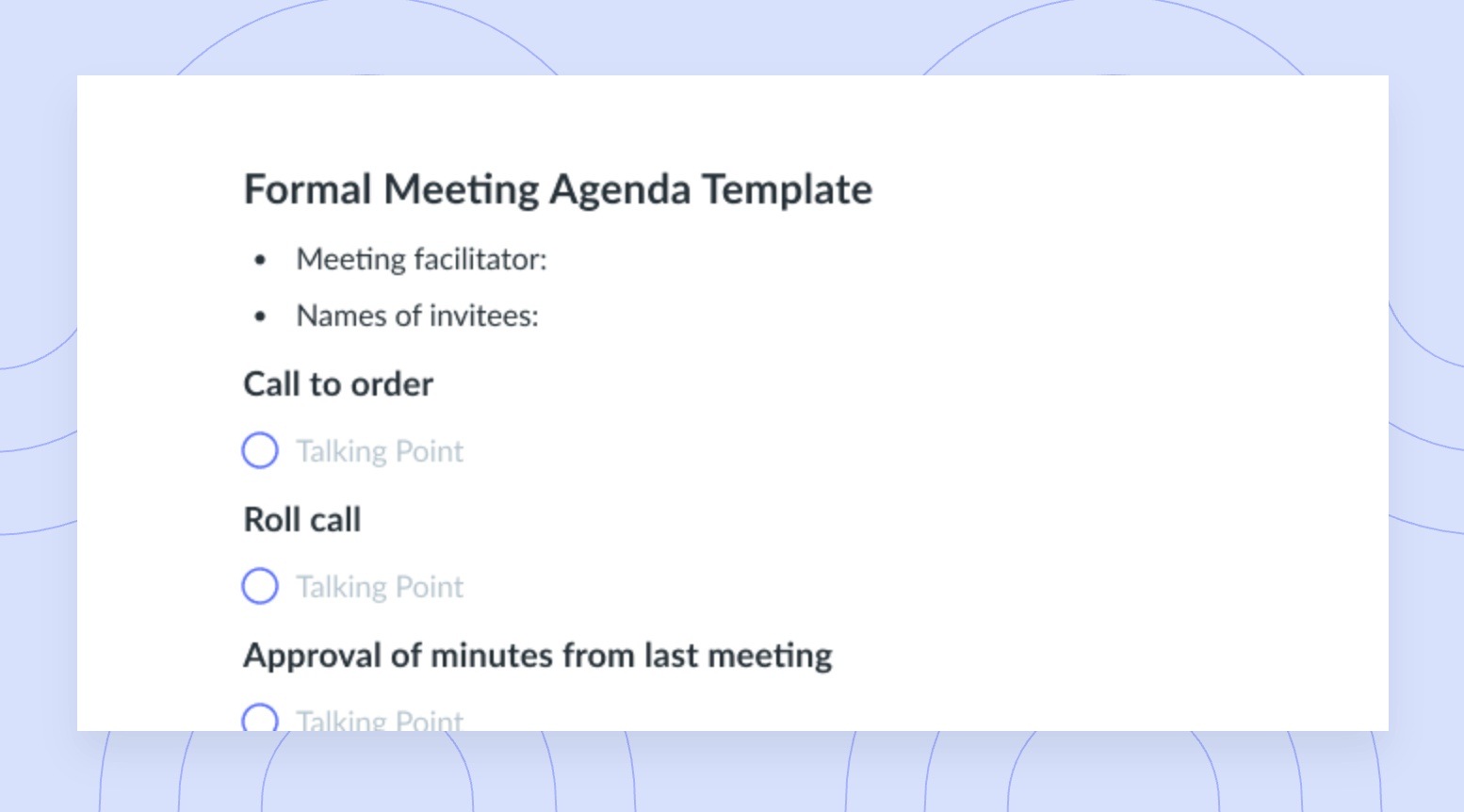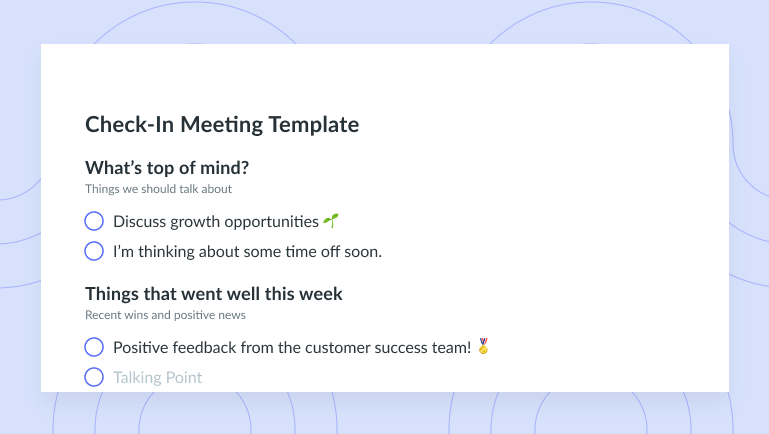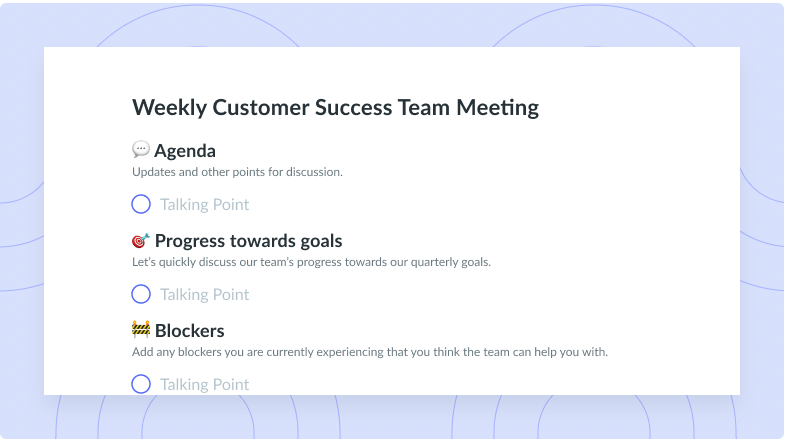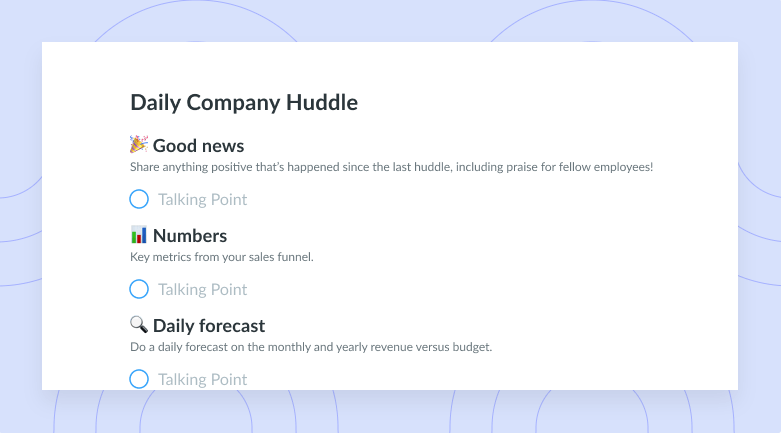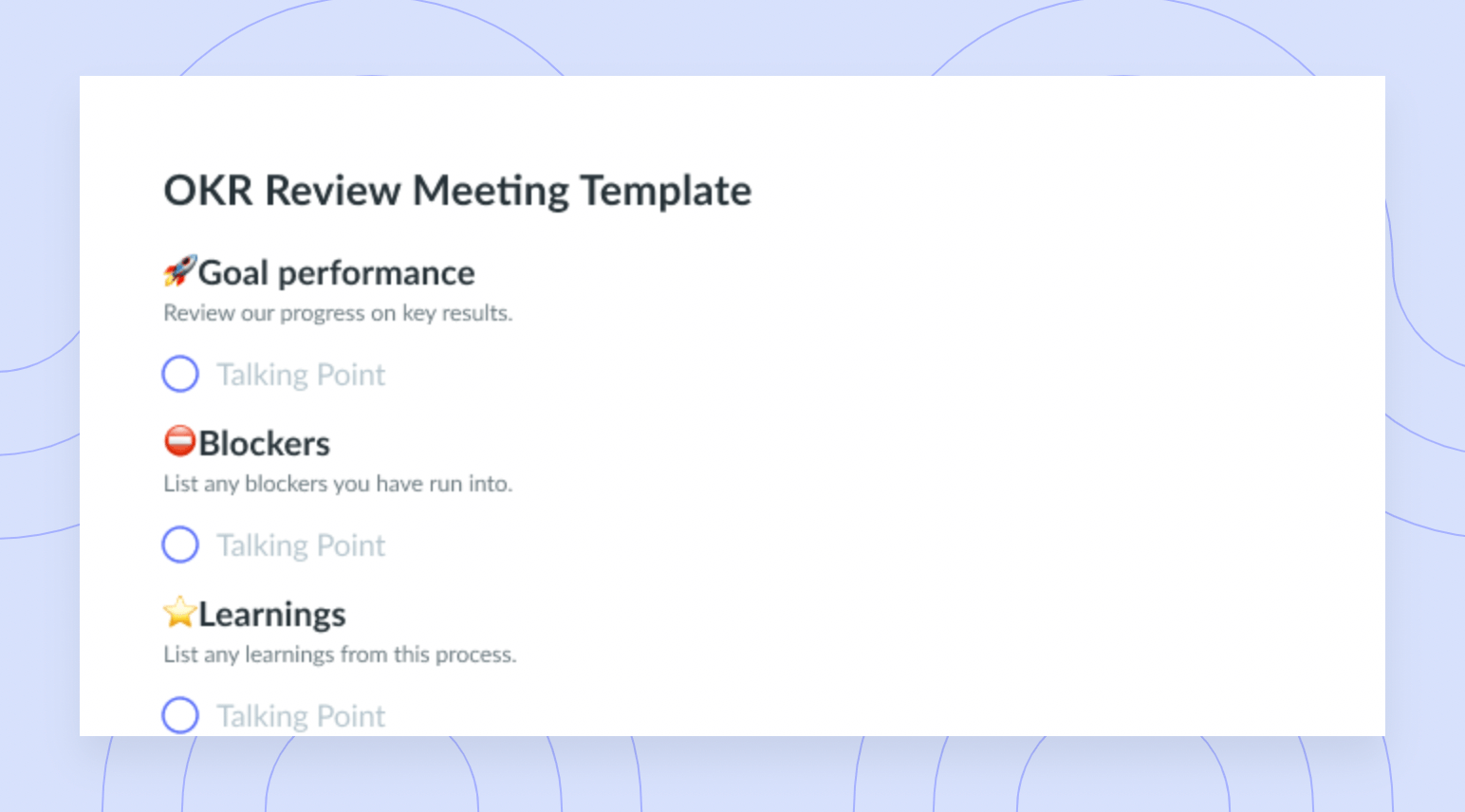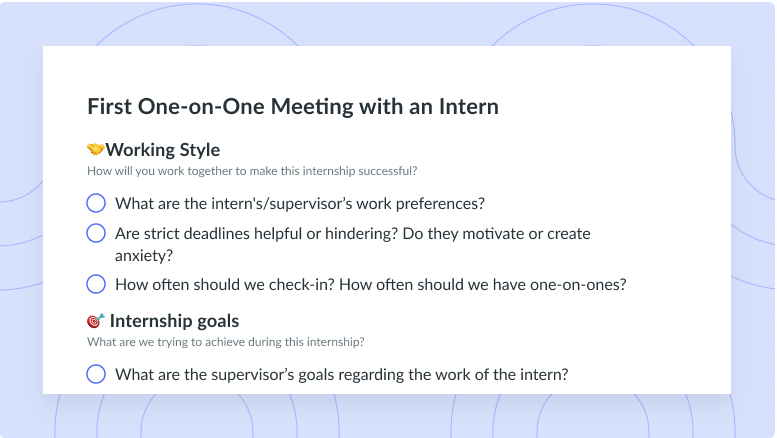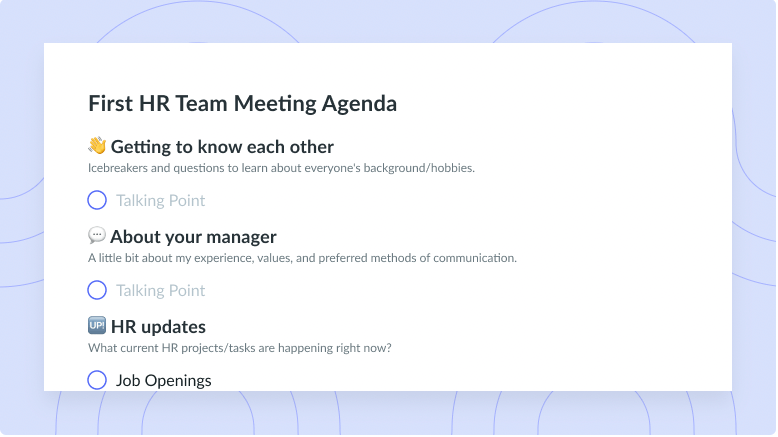How to Set Meeting Goals That Work This 2024
If you’re looking to improve productivity, collaboration, and motivate your employees, think about setting a goal for every meeting you schedule.
It may seem like setting a meeting goal is common sense, but the truth is, there’s a lot more to it. In order to run and participate in an effective meeting, it’s essential that you set meeting objectives in advance, so that you have a goal to work towards in the amount of time allotted to meet.
Meeting goals guide your conversations so that you stay focused, on topic and as productive as can be. Whether there are a few meeting objectives you’d like to accomplish or a big decision to be made, it’s important to be organized, prepared and to stick to your agenda by using a collaborative agenda template.
Since there are quite a few different types of meeting goals that you can set, Fellow has put together a guide with 7 types of meeting goals that you can set, depending on the nature of your project and what you and your team are looking to accomplish. We also quoted one of our favourite books, The Making of a Manager, throughout the article. Keep scrolling to learn more!
What are meeting goals?
Meeting goals are essentially the results that you want to obtain by the end of your meeting. Depending on the nature of the project that you and your team are working on, you can have many smaller meeting objectives, or a major overarching goal.
Your meeting goals should be fully laid out in your agenda so that you can build all of the necessary steps to work towards achieving one or multiple goals by the end of your team meeting.
If your team isn’t committed to strictly following a meeting agenda, sadly, the meeting isn’t likely to work out! Before you finalize the topics you’ll be covering to reach your meeting goal(s), make sure you get your team members’ input and that their voices are heard.
Why setting goals for every meeting is important
It’s important to set at least one goal for each meeting because it’s possible that you will lose focus if you don’t. You and your team members are likely to have differing opinions on the most important or pressing topics to address. This is why creating a collaborative agenda or asking for suggestions ahead of time is crucial.
It’s valuable to understand what attendees think is important to bring up and that their thoughts are considered because there may be issues or points of interest that you wouldn’t have been made aware of. In addition, having a common goal to work towards is going to bring you and your team closer together, as you work towards success.
How to set goals for a meeting
How you set goals for an effective meeting is going to depend on the current stage and status of your project. Remember that you want to set realistic goals so that you can actually accomplish them! Be reasonable and after seeing how much you and your team can get done in a certain amount of time, and then consider building on them if you’re able to.
Here are some of the most common and most important types of meeting goals to be familiar with organizing and executing important organizational objectives:
- Planning
- Problem-solving
- Decision-making
- Relationship and culture building
- Getting work done
- Sharing feedback or reviewing work
- Retrospection and adjustments
7 examples of meeting goals
1 Planning
Planning meetings are important to set a direction for the future of the team and the organization as a whole.
One example of a planning meeting could be a quarterly leadership meeting, where company leaders plan objectives and milestones for the 90 days ahead.
Before the planning session, we recommend getting all meeting attendees to prepare metrics, documentation, and relevant information, so the goal-setting process that takes place during the meeting is easier to accomplish.
Author of The Making of a Manager, Julie Zhuo writes:
“The best idea generation comes from understanding that we need both time to think alone (because our brains are most creative when we’re by ourselves) and time to engage with others (because hearing different perspectives creates sparks that lead to even better ideas).”
2 Problem-solving
Breaking down a problem and finding a solution is much easier and much more enjoyable when you’ve got others to bounce your ideas off of. Meetings that are set for problem-solving are valuable for mediating obstacles that you encounter during the progression of your project.
One example of a problem-solving meeting is a brainstorming session where your team gathers to solve an existing problem together.
Once again, we recommend asking all attendees to come prepared with ideas and suggestions, and even better, write them down in the meeting agenda before the brainstorming session. This will empower the quieter members of the team to contribute with their ideas.
“To ensure that you get optimal results from your brainstorming session, inform all attendees as early as possible so they can block the time off in their calendars. Consider passing along an agenda in advance so people will know how their time will be spent, and present them with the main question you’ll be looking to solve so they can prepare some thoughts in advance and hit the ground running.”
– Courtney Symons, Editor in Chief at Shopify
Download our definitive guide on team meetings to learn how companies like Shopify, Webflow, and Figma run their meetings.
3 Decision-making
Whenever an important decision needs to be made, it’s essential to gather the key stakeholders involved. Guests on our podcast have recommended using the RACI framework for decision-making, which is popular in project management, especially when these decisions are being made at higher levels of company strategy and will produce significant outcomes.
RACI stands for:
– Responsible
– Accountable
– Consulted
– Informed
If you’re organizing a decision-making meeting, it might be a good idea to decide who in the room is responsible, accountable, or should be consulted and/or informed.
In The Making of a Manager by Julie Zhuo, she highlights the simplest way to make these big decisions:
“Check egos at the door. No winners or losers… You’ll need to abide by the decisions made in these meetings just like everyone else.”
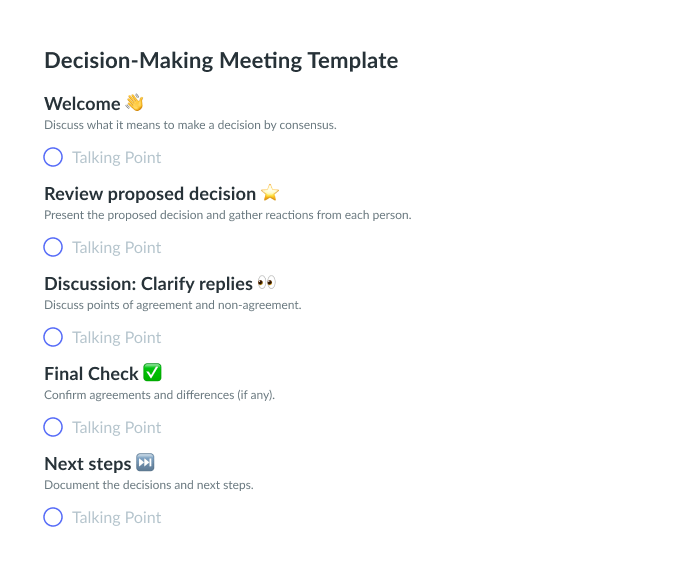
4 Relationship and culture building
Relationship and culture building should be really important to any leader.
Two great examples of relationship-building meetings are one-on-one meetings to build trust with your direct reports, and all-hands meetings, where the company gets together to celebrate wins and milestones.
It’s important to bring people together so that they feel that they are part of the collective success of the organization. In fact Julie Zhuo highlights:
“To have a high-functioning team, people need to work well with one another, so you need to find ways to nurture empathy, create trust, and encourage collaboration. Sometimes, you may decide to get a group of people together for the simple purpose of focusing on relationships.”
5 Getting work done
Working sessions are simply when two or more individuals meet (in-person or virtually) to work on a project together. In these meetings, you’re quite literally working as you move through the meeting.
A great example of this is when designers collaborate simultaneously on a board, or when teammates work on the same presentation at the same time. Technology has enabled a lot of this online collaboration and there’s tons of meeting tools to choose from to produce great results with your teammates and hit those meeting objectives.
It’s great to work with a specific amount of time for these sessions to see how much you can get done in a limited working block.
6 Sharing feedback or reviewing work
Feedback or review goals are usually set for meetings where you want to check-in on the progress that has been made. These goals are useful to set for project check-ins, quality checks and great for issuing logs to see what’s been resolved and what still needs some attention.
“Above all, think about how to guide the discussion in a way that feels safe. Consider time-boxing complex topics and hearing feedback “around the room” one at a time, so that those who feel less comfortable in group settings have a designated time to speak up. You can also run written exercises with sticky notes (either physically or digitally) and break out into smaller groups, which can feel more inviting for some.”
– Noah Levin, Design Director at Figma
If you’re looking to get feedback from your peers, it’s always helpful to send a feedback form before the meeting with specific things you’d like them to think about and address.
Fellow enables your team to share real-time feedback on meetings, projects, and performance.

7 Retrospection and adjustments
Retrospective meetings are there to help your team reflect back on what worked well and what could be improved about a specific project or process.
If each attendee comes prepared to the meeting with a few items to bring up, it creates a collaborative conversation where you can leverage which points come up the most frequently and recognize what needs to be given attention.
Try to think about setting goals for future projects of similar nature so that you can apply your learnings directly. It’s a good idea to set these goals and host your reflective meeting recently after a project has been completed so that it’s fresh in your mind.
Closing thoughts
If your team is goal-oriented, setting specific meeting goals will help them feel more motivated to work together to achieve collective success. Understanding different types of meeting goals is going to help you tailor the way in which you create meeting objectives to be specific to the purpose of your discussion. The conclusion of your meeting should be documented in Fellow’s objective tab to keep track of the goals set through the quarter.
Make sure that once the meeting is done, you go over your results to see what has been achieved. If you haven’t managed to hit the meeting goal that you initially set, consider why. Was the meeting goal clearly defined?
Incorporate this good habit of always setting meeting objectives and watch your team feel more productive, more motivated and overall more purposeful.
As always, it’s a pleasure to see you on the Fellow blog! If you enjoyed this read, be sure to pass it on to a friend or a colleague. If this topic is of interest to you, you can also check out our podcast on optimizing learning and building efficient teams.
![How to Set Productivity Goals for 2024 [+ Examples]](https://fellow.app/wp-content/uploads/2023/12/productivity-goals-2.jpg)








